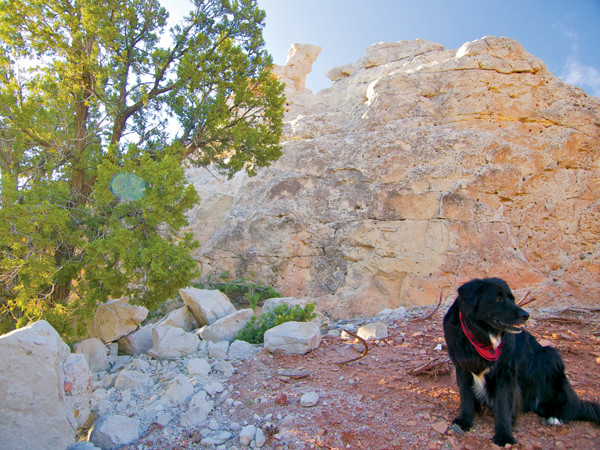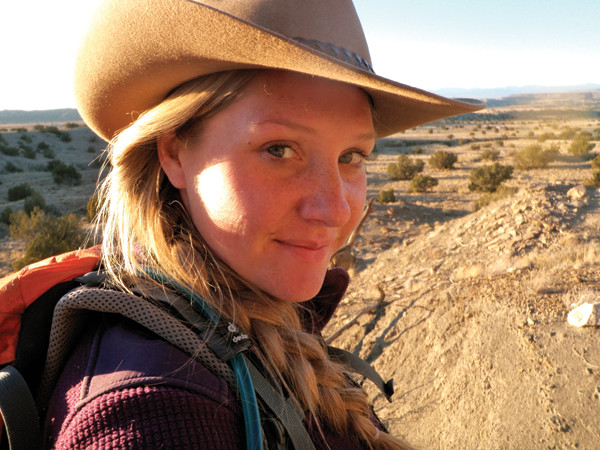
by Mary Caperton Morton Wednesday, November 20, 2013

A rock formation in the Garden of the Gods, N.M., before a rockfall. Mary Caperton Morton

The rock formation in the Garden of the Gods, N.M., after the rockfall. A white scar on the fin marks the site of the erosion. Mary Caperton Morton

The rockfall left a smattering of bright white rock all over the ground. Mary Caperton Morton

Mary Caperton Morton
Editor's Note: Traditionally, EARTH has published a "highlights" or "year in review" issue at the end of the year. This year, we decided to try a new approach: We asked our staff and some frequent contributors to write a short commentary on something that grabbed their attention in 2013. We gave everyone carte blanche. What follows is a collection of extremely varied, often very personal insights into how the planet impacted each individual. You can find some online this month, but for the full grouping, you'll have to buy the issue here or subscribe.
Writing about geology for EARTH often requires thinking in terms of incomprehensibly long timescales. But every now and then, Earth, the planet, reminds me that geology also happens in real time.
Last summer I was in the right place at the right time to witness a rockfall in one of my favorite places: Garden of the Gods in New Mexico (not to be confused with Garden of the Gods in Colorado Springs, Colo.). The name is not hyperbole. This place is a geologic wonder. Massive 15-meter-high fins of Dakota Sandstone cut through the Galisteo Basin, trending north-south, just north of the turquoise-mining village of Los Cerrillos along the historic Turquoise Trail.
These thick slabs of white, yellow and pink sandstone formed before the time of the dinosaurs, when this region was covered by an inland shallow sea. About 27 million years ago, during the uplift of the Sangre de Cristo Mountains, the layers were broken apart into slabs and stood vertically on end.
The slabs beg to be climbed, but the rock is quite crumbly, easily shedding sand and pebbles under foot and fingertip. Still, I’ve explored all the fins and have come to know them quite well. Whenever I find myself in New Mexico, I pay them a visit and say hello to old friends.
One morning last summer, after a rare overnight rainstorm, my dogs and I were sitting outside among the rocks, watching the sandstone light up as the sun rose over the Sangre de Cristos. The moment the first rays hit the crown of one white sandstone fin, it exploded. With a startling shotgun crack and a tremendous rumble, the whole top of the formation collapsed, spraying bright white rock all over the ground.
I jumped up and ran over to inspect the damage, careful to stay out of the fall line. The fin bore a white scar where fresh rock was newly exposed. Still damp from the night before, the rock steamed slightly in the sun, the vapors mixing with the cloud of white dust hanging in the air. Boulders, pebbles and particles of white rock lay scattered on the ground on both sides of the fin. “So this is how it happens,” I thought. Geologic time really does include “now.”
Whenever I’m visiting places like Arches National Park in Utah or the Wheeler Geologic Area in Colorado, where bizarre rock formations are as extreme now as they may ever be, I always feel lucky to be living in this era of Earth’s geologic history. Someday, the fins, arches and hoodoos will be gone, crumbled to dust by freezing, thawing and the first warm rays after rain. But for now, they are here and we are here, and there is something to be said for being in the right place at the right time in Earth’s mind-bendingly long geologic history.
As 2013 passes into 2014, I wonder what scientific breakthroughs will be discovered this year because the right eyes and minds are at the right place at the right time to witness geologic history as it happens. And what will I experience in the coming year that will change the way I think about Earth and its geologic processes? I don’t know yet, but I plan to visit as many rocks and watch as many sunrises as possible to find out.[]{#Find web stories}\
© 2008-2021. All rights reserved. Any copying, redistribution or retransmission of any of the contents of this service without the expressed written permission of the American Geosciences Institute is expressly prohibited. Click here for all copyright requests.